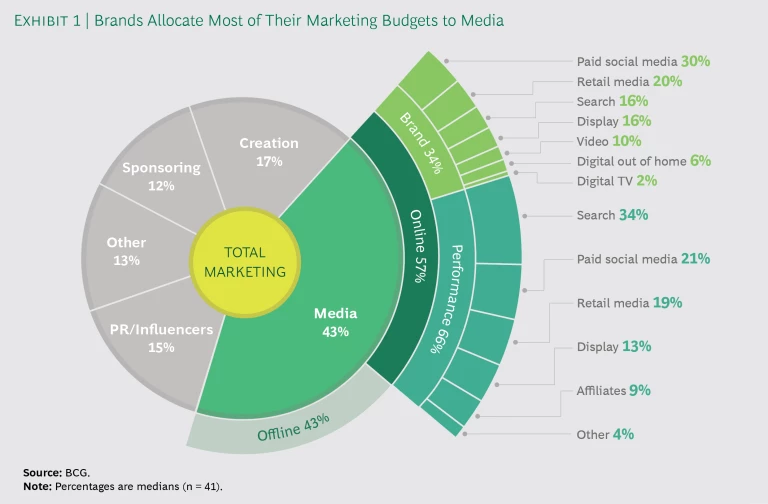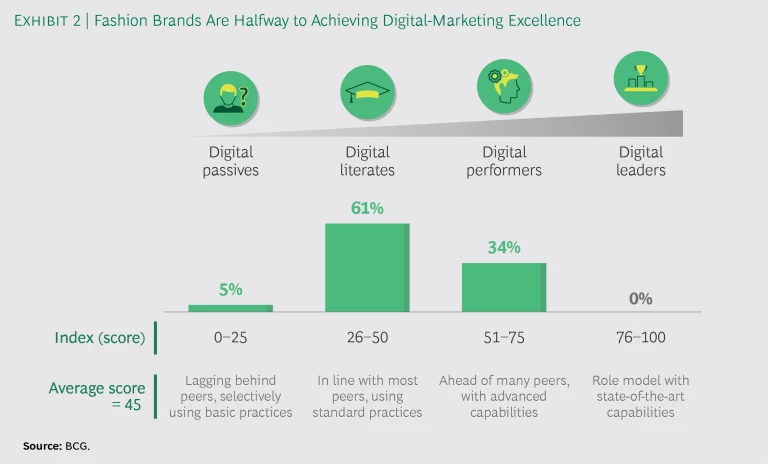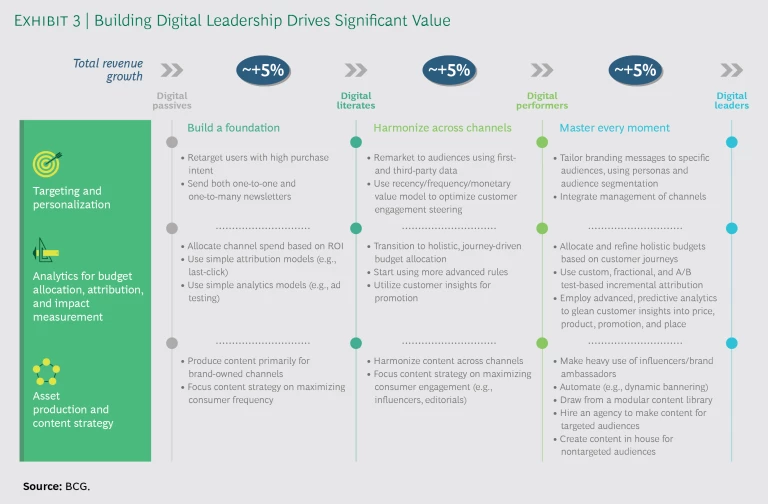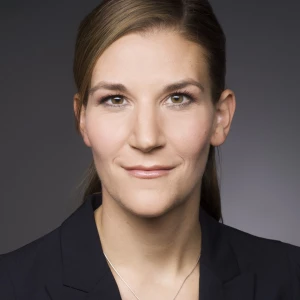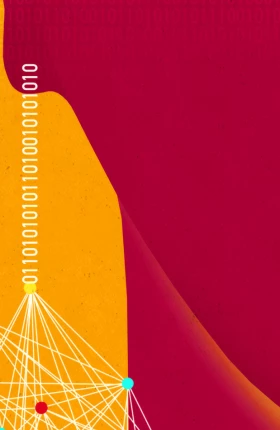E-commerce fashion sales are growing three times faster than sales at brick-and-mortar stores. More than 25% of fashion sales in Western Europe are expected to take place online by 2020—many on platforms, or websites where various fashion brands sell their wares—up from 20% today. In light of that growth, the marketing of fashion brands has migrated online as well.
But while many fashion brands talk the talk when it comes to digital marketing, few truly walk the walk. For example, while 76% of brands see personalization as highly important, only 13% use it comprehensively. Generally speaking, brands are only at the halfway point when it comes to achieving digital-marketing excellence . They have a lot to gain by taking these digital-marketing capabilities from basic to state of the art, including a 15% increase in revenues, on average.
To assess the digital-marketing capabilities of fashion brands, BCG joined forces with Zalando Marketing Services, the digital-marketing unit of the European fashion platform Zalando . We surveyed 90 leading global fashion brands from 40 fashion groups and complemented the insights that emerged by conducting deep-dive interviews with senior executives in Western Europe. (See “BCG’s Digital-Marketing Assessment.”) The survey and interviews provided insights into the breakdown of online and offline sales, how brands are allocating their digital-marketing budgets, what stage they're at on the journey toward digital-marketing excellence, and what they need to do to get there.
BCG’s Digital-Marketing Assessment
BCG’s Digital-Marketing Assessment
We assessed brands’ digital-marketing excellence along six capability and operational dimensions: targeting and personalization; cross-channel integration; campaign planning and execution; analytics for budget allocation, attribution, and impact measurement; asset production and content strategy; and organizational setup and agency model.
Across all these dimensions, the average score was 45 out of 100. A small number of brands (5%) are selectively engaging in only the most basic digital-marketing practices and fall into the category we call digital passives. The vast majority—61%—are digital literates, meaning that they use standard digital-marketing techniques. Digital performers, which make use of more sophisticated capabilities, account for 34% of the brands we surveyed. None are digital leaders—brands that have achieved excellence by using state-of-the-art digital-marketing capabilities across the board.
How Brands Approach Marketing Fashion Online
Marketing online is inherently more complex than it is offline. There are a seemingly endless number of channels and formats, and the expectations of consumers are different; they want every interaction that they have with brands to take place in real time and to be both personalized and relevant to their specific needs. Brands therefore take different factors into consideration when making digital-marketing decisions.
Platforms drive online sales. Powering the rise in online sales are fashion platforms—in particular, fashion marketplaces, where multiple fashion brands sell their wares directly to consumers. While sales on fashion platforms are currently about equal to those on brands’ own e-commerce sites, they are expected to grow and eventually overtake the latter, with marketplace platforms climbing 12% a year through 2020, compared with a projected 8% rise of sales on brand-owned sites.
Brands plan to increase online media spending. The biggest item in fashion brands’ marketing budget (43%) is media spending, 57% of which has migrated online. (See Exhibit 1.) Two-thirds of online media spending goes to performance marketing and the rest to branding. However, there are material differences by category: while streetwear brands spend more than 40% of their online media budgets on branding (content marketing and style guides, for instance), shoe and sportswear brands spend just 20% and 26%, respectively.
In the case of both performance and branding marketing, the three most important digital-marketing vehicles are paid social media, search, and retail media (advertising on wholesale and marketplace platforms). Going forward, more than 95% of the brands we surveyed plan to increase their online media spending significantly. Approximately 85% plan to increase spending on paid social media, and approximately 60% plan an increase in retail media, in line with the increase in platform sales.
Most brands have not yet achieved digital-marketing excellence. While brands are spending a lot on digital marketing, on average, they're only at the halfway point in their potential when it comes to achieving digital-marketing excellence. (See Exhibit 2.) Indeed, across all capability and operational dimensions, the average level of excellence at the brands we surveyed was 45 out of 100. However, we found a number of companies that are excelling on a single dimension. For example, some brands are particularly good at content strategy but not at targeting, and vice versa.
Three Digital-Marketing Success Factors
The brands most advanced in their journey to overall digital-marketing excellence are excelling in three dimensions:
- Analytics for budget allocation, attribution, and impact measurement
- Targeting and personalization
- Asset production and content strategy
These companies engage in various best practices—from the use of dynamic attribution techniques to the creation of user- and influencer-generated content—that fashion brands wishing to increase their competitiveness might want to follow.
Analytics for Budget Allocation, Attribution, and Impact Measurement
Only a handful of the brands we surveyed are digital leaders in analytics for budget allocation, attribution, and impact measurement. The majority are digital performers or digital literates whose efforts are still limited to deploying last-click attribution, for example, and allocating budget based on output-oriented ROI. But given the complexity of digital marketing, mastering analytics in order to make the most efficient and effective marketing decisions is key. The following are among the best practices in which digital leaders in analytics engage.
Attribution Techniques. Without exception, digital leaders in analytics use dynamic attribution techniques (such as fractional, multitouch journey attribution), compared with 23% of fashion brands overall. They also optimize the allocation of their performance budget along the entire customer journey. For example, a sporting-goods manufacturer dynamically adapted its media mix during a launch campaign to different stages in the product life cycle, using the most appropriate techniques for each—from generating awareness through sponsorships to driving consumer engagement with social media to boosting sales through performance marketing.
Given the complexity of digital marketing, mastering analytics in order to make the most efficient and effective marketing decisions is key.
Predictive Analytics. All digital leaders use predictive analytics to optimize digital-marketing effectiveness, compared with just 43% of fashion brands overall. Specifically, they extract customer insights in terms of price, product, promotion, and place from previous purchase behavior in order to segment leads, tailor content distribution, and optimize marketing campaigns according to predicted churn rate, cross-selling and upselling potential, product fit, and customer lifetime value.
Cross-Channel Data. Compared with just 27% of fashion brands overall, 67% of digital leaders in analytics closely link online and offline customer data in order to address consumers wherever they are, at any time. One global fashion brand has developed a complete view of its customers using advanced data-capturing techniques; information includes everything from past purchases to the garments a customer has tried on based on RFID tag data. Sales associates can use these profiles to make the most relevant product suggestions possible. And when a customer is near or in one of the company’s stores, the brand's app sends out location-based marketing messages and product recommendations.
Targeting and Personalization
None of the brands we surveyed has achieved digital-leader status when it comes to targeting and personalization. But we found the following best practices among digital performers in this category.
Audience Targeting. More than 80% of digital performers use audience-driven advertising— which uses a combination of first- and third-party data to create ads for specific audience segments, such as those based on income or age—complemented by contextual targeting (ads generated according to the channel or stage in the customer journey) and geotargeting (ads generated according to the customer’s location). By comparison, only 29% of brands overall use audience targeting frequently. BCG helped one global fashion brand draw from a library of creative assets to target different audiences. It used A/B testing to find out which combination of 30 different video ads covering seven different creative concepts resonated best with 35 different social media audiences; the initiative boosted the ad view rate by 80%.
First-Party Data. More than 80% of digital performers in the targeting and personalization category use first-party data, especially real-time or near-real-time data that they can segment in order to target specific (and often narrow) audiences.
Personalized Digital Marketing. Less than 10% of fashion brands personalize their messages in email, paid social media, and display advertisements. For the most part, e-commerce is not personalized either; just 38% of brands have a fully personalized recommendation engine, and only 21% merge their online and offline service to give their customers a truly seamless omnichannel experience. However, digital performers in this category are already using personalization extensively, especially when it comes to recommendation engines for the creation of content (75%), user experience and services such as adaptive websites (75%), and the convergence of online and offline channels (63%)—enhancing the in-store experience with digital information, for example.
Brands needs to personalize all customer communications and rewards across all channels, not just online/digital.
Brands need to personalize all customer communications and rewards across all channels, not just online/digital. Every experience with a fashion brand online should be tailored to the customer’s profile, location, and browsing and purchasing history. (See "
Profiting from Personalization
," BCG article, May 2017.) BCG helped implement an advanced-analytics-based approach to drive personalization at a global jewelry manufacturer by focusing on three applications: personalized emails (using a recommendation engine), adaptive webpages (using interactive landing pages), and social media (using personalized ads). In the first few days after the company sent out the personalized emails, online sales rose approximately 50%.
Asset Production and Content Marketing
The amount that brands spend on digital content rises as they get closer to digital-marketing excellence. Leaders in this category invest approximately 30% more on content creation than digital literates, for example. The following best practices are common to both the digital leaders and the digital performers we surveyed.
User- and Influencer-Generated Content. All the leaders in this category utilize content created by users and influencers—everything from videos taken at industry events to casual photos taken in the course of the day. Traditional PR spending is increasingly shifting online, with 27% of all brands now using influencer marketing and more than 80% planning to increase their spending on such content. To maximize reach, user- and influencer-generated content tends to be distributed via multiple channels—Instagram, YouTube, fashion blogs, and other social media—by both brands and the users and influencers themselves. For example, a designer lifestyle brand refreshed its image and significantly increased online traffic (up 60%), consumer engagement (2.5 billion impressions across major channels and more than 10 million likes), and sales (a 26% rise in global womenswear) by partnering with a top model and social media celebrity with more than 30 million followers. The influencer posted pictures of shoppable content from a festival-inspired runway show on social media, along with a "See now, buy now" button.
The amount that brands spend on digital content rises as they get closer to digital-marketing excellence.
Increased Spending on Content. Digital performers in this category spend 13% of their total marketing budget on digital-content marketing, compared with 9% by fashion brands overall. Performers tend to take charge of more content creation themselves, spending almost 60% of the amount allocated to this function on in-house production, compared with just 25% on content created with media agencies. They may also try to follow the lead of digitally native brands, which produce low-cost (but high-quality) content such as backstage videos from fashion shoots or production facilities.
A Network of Creative Assets. To create, manage, and distribute content, digital-marketing leaders use data science in combination with modular libraries of creative assets. Campaigns are optimized across platforms and devices using content analytics and automated marketing tools, such as dynamic banner ads.
Digital-Marketing Excellence Boosts the Bottom Line
Although some fashion brands are making use of these best practices, more recognize their importance than are actually adopting them. As noted above, for example, while 76% of brands think personalization is important, just 13% are using it extensively. And while 51% and 30% think the same about AI and curated shopping, respectively, none of the brands we surveyed had actually begun using those digital-marketing tools. Yet achieving digital-marketing excellence can increase revenue by 15% overall.
For brands that are currently digitally passive—selectively engaging in the most basic of digital-marketing practices and generally lagging behind the efforts of their peers—the first step to digital literacy is to lay a foundation for the necessary skills and capabilities. (See Exhibit 3.) That means adopting standard digital-marketing tools such as retargeting, segmented newsletters, simple attribution and analytic models, and content production for their own brand channels. These practices alone can lift a brand’s revenue by roughly 5%.
Becoming a digital performer will add about another 5% to a brand's top line. To reach this level, brands must harmonize their content across all channels. That includes synthesizing data from disparate areas of the organization in order to drive automation and making better use of analytical models for attribution and budget allocation. They also need to bring together cross-functional teams to focus on digital marketing. (See The Digital Marketing Revolution Has Only Just Begun , BCG Focus, May 2017.)
To achieve the level of digital leader—and in the process increase revenue by another 5%—brands must master every moment. That means using both online and offline data to build a single view of each customer in order to track how he or she reacts to or interacts with individual marketing initiatives. And brands should quantify the value of every marketing moment by linking it to subsequent sales and measure that value against tangible business outcomes.
Brands also need digital-marketing talent. Approximately one-third of the fashion brands we surveyed reported that a lack of necessary talent and expertise is among their key roadblocks to realizing the full potential of digital marketing. (See "
A Disconnect and a Divide in Digital-Marketing Talent
," BCG article, March 2017.) By hiring people with skills that expressly support digital marketing, such as programmatic buying specialists, data scientists, and channel-specific content managers, they can build a distinct advantage over competitors. But they must change their ways of working, too, by fostering a more agile, test-and-learn culture with cross-functional teams that reward the sharing of best practices. And they need to ensure that those digital skills and ways of working extend beyond the company to agency partners and other members of their talent ecosystem.
As fashion sales migrate online, fashion brands are increasingly moving their marketing spending online as well. Yet despite the growth in digital-marketing budgets, most brands aren’t utilizing the most efficient and effective digital-marketing techniques available and, as a result, are missing out on the significant revenue uplift that such techniques can yield. To maximize the opportunity, brands need to identify how far they still have to go before reaching digital-marketing excellence, prioritize the most value-adding initiatives, and then commit to doing what’s needed to get there.

